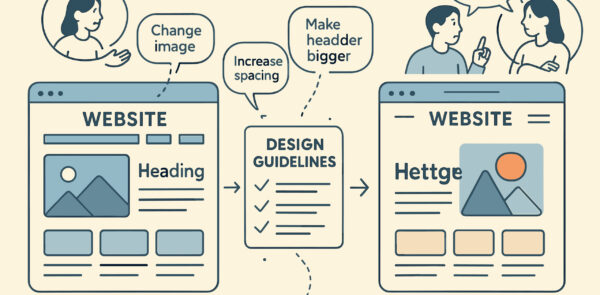
Jump to a section:
Designing an SEO-friendly website in 2026 requires sophisticated understanding of Google’s evolving algorithms, technical performance standards, and user experience priorities that have fundamentally transformed from keyword-focused approaches to comprehensive user value creation.
- The 2026 SEO landscape reflects Google’s transition toward AI-enhanced search understanding, where algorithmic sophistication evaluates website quality through holistic user experience metrics rather than isolated optimization tactics.
- Core Web Vitals have become foundational ranking factors, with passing thresholds now considered minimum requirements rather than competitive advantages, while sites failing to achieve “good” status experience significant ranking penalties.
- Mobile-first indexing reaches completion, with Google exclusively using mobile versions for crawling and ranking, making responsive design and mobile performance optimization essential for search visibility.
- Semantic search advancement demands content architecture that demonstrates topical authority through entity relationships, structured data implementation, and comprehensive topic coverage that satisfies user intent beyond individual keyword targeting.
- Accessibility compliance transitions from optional enhancement to legal requirement, with WCAG 2.2 standards becoming mandatory for public entities by April 2026 while private businesses face increasing litigation risks for non-compliant digital experiences.
Technical Foundation and Core Web Vitals Excellence
Technical SEO forms the invisible foundation upon which all other optimization efforts build, requiring systematic attention to site architecture, performance optimization, and crawlability that enables search engines to effectively discover, process, and index website content. The evolution from basic technical requirements to sophisticated performance standards demands comprehensive understanding of server optimization, resource loading priorities, and user experience metrics that directly influence ranking algorithms.
Core Web Vitals represent Google’s definitive user experience measurements, with Largest Contentful Paint (LCP), Interaction to Next Paint (INP), and Cumulative Layout Shift (CLS) serving as direct ranking factors that determine search visibility and user satisfaction. Achieving optimal Core Web Vitals requires strategic approach to image optimization, JavaScript management, and CSS delivery that prioritizes critical rendering paths while minimizing resource blocking and layout instability.
Site architecture optimization involves creating logical, flat hierarchical structures that enable both users and search engines to navigate efficiently from homepage to any content within three clicks. This architectural approach distributes page authority effectively while ensuring comprehensive crawl coverage that prevents orphaned pages and indexing gaps. URL structure standardization, internal linking strategies, and XML sitemap optimization support this architectural foundation while providing clear signals about content importance and relationships.
“Technical excellence isn’t just about satisfying algorithms – it’s about creating digital experiences so smooth and reliable that users forget they’re navigating a website. When technical optimization becomes invisible to users while remaining highly visible to search engines, you’ve achieved the perfect balance.” – Strategy Team, Linchpin SEO
Essential Technical Foundation Elements:
- Core Web Vitals Optimization: LCP under 2.5 seconds, INP under 200ms, and CLS under 0.1 for 75%+ of page loads
- Mobile-First Performance: Responsive design with mobile-specific optimization for loading speed and touch interface usability
- Structured Site Architecture: Logical hierarchical organization with flat structure enabling efficient crawling and clear content relationships
- Security and Accessibility: HTTPS implementation, WCAG 2.2 compliance, and comprehensive security headers configuration
- Advanced Crawlability: Optimized robots.txt, XML sitemaps, and structured data implementation that guides search engine understanding
Table: Core Web Vitals Impact on SEO Performance
| Metric | Good Threshold | Ranking Impact | User Experience Effect |
|---|---|---|---|
| Largest Contentful Paint (LCP) | ≤2.5 seconds | High – Direct ranking factor | Perceived loading speed, engagement |
| Interaction to Next Paint (INP) | ≤200 milliseconds | High – User interaction quality | Responsiveness, user satisfaction |
| Cumulative Layout Shift (CLS) | ≤0.1 | Medium-High – Visual stability | Reading comfort, click accuracy |
| First Contentful Paint (FCP) | ≤1.8 seconds | Medium – Supporting metric | Initial loading perception |
Semantic HTML Structure and Content Architecture
Semantic HTML implementation provides search engines with clear content context and hierarchy that enables sophisticated understanding of page purpose, content relationships, and structural importance beyond simple keyword analysis. Modern search algorithms leverage semantic markup to determine content relevance, authority signals, and user intent satisfaction through systematic evaluation of HTML element usage and content organization patterns.
Proper heading hierarchy using H1-H6 tags creates content outlines that both users and search engines can navigate efficiently, with each heading level representing logical content subdivision that supports reader comprehension and algorithmic content parsing. The strategic use of semantic elements like article, section, header, footer, and nav provides contextual signals that help search engines understand content purpose while improving accessibility for screen readers and assistive technologies.
Content architecture extends beyond individual page optimization to encompass site-wide topical authority development through strategic internal linking, content clustering, and entity relationship building. This holistic approach demonstrates expertise across related topics while supporting user journey optimization and search engine understanding of content depth and breadth within specific knowledge domains.
Critical Semantic HTML Implementation Elements:
- Proper Heading Hierarchy: Logical H1-H6 structure that creates clear content outlines for users and search engines
- Semantic Element Usage: Strategic implementation of article, section, header, footer, and nav tags that provide contextual content signals
- Accessible Markup: Alt text, ARIA labels, and keyboard navigation support that ensure inclusive user experiences
- Entity Recognition Support: Markup that helps search engines identify and understand key entities, topics, and relationships
- Content Relationship Signals: Internal linking and content organization that demonstrates topical authority and expertise
Structured Data Implementation and Rich Results Optimization
Structured data implementation using JSON-LD format provides search engines with explicit content understanding that enables rich result generation, knowledge graph integration, and enhanced search result presentation that improves click-through rates and user engagement. The systematic application of Schema.org vocabulary helps search engines comprehend content context, relationships, and attributes that traditional HTML parsing cannot reliably determine.
Strategic structured data implementation requires careful selection of schema types that align with business objectives and content purposes, focusing on high-value implementations that support rich result eligibility while avoiding over-marking or incorrect usage that can trigger search engine penalties. Priority implementation typically includes Organization, LocalBusiness, Article, Product, and FAQ schemas that address common business needs while supporting diverse rich result opportunities.
Advanced structured data strategies involve entity relationship mapping that connects related content pieces through shared entities, supporting topical authority development and knowledge graph integration. This comprehensive approach enables search engines to understand content connections across multiple pages while supporting advanced result features like knowledge panels and entity carousels that enhance brand visibility and authority demonstration.
Strategic Structured Data Implementation Framework:
- JSON-LD Priority Implementation: Clean, header-based structured data that doesn’t interfere with page content while providing comprehensive schema coverage
- Business-Critical Schema Types: Organization, LocalBusiness, Product, Article, and FAQ schemas that support core business objectives
- Rich Result Eligibility: Strategic schema selection that maximizes rich snippet, knowledge panel, and enhanced result opportunities
- Entity Relationship Mapping: Connected structured data across pages that demonstrates topical authority and content relationships
- Quality Assurance and Testing: Systematic validation using Google’s Rich Results Test and ongoing monitoring for implementation accuracy
Table: Structured Data Implementation Priority and Impact
| Schema Type | Implementation Priority | Rich Result Potential | Business Impact |
|---|---|---|---|
| Organization | Critical | Knowledge Panel, Brand Results | Brand recognition, credibility |
| LocalBusiness | High | Local Pack, Business Info | Local discovery, contact info |
| Article/Blog Posting | High | Article Rich Results, News Carousel | Content visibility, engagement |
| Product | High | Product Rich Snippets, Shopping | E-commerce performance, sales |
| FAQ | Medium-High | FAQ Rich Results, Answer Boxes | Information discovery, authority |
Mobile-First Design and Responsive Architecture
Mobile-first design philosophy prioritizes smartphone and tablet experiences as primary design considerations, with desktop layouts serving as progressive enhancements rather than primary targets. This approach aligns with Google’s mobile-first indexing while acknowledging that mobile users now represent the majority of web traffic across most industries and geographic markets.
Responsive architecture implementation requires sophisticated CSS techniques including flexible grids, scalable images, and adaptive typography that maintain visual hierarchy and usability across diverse screen sizes and device capabilities. Modern responsive design extends beyond simple layout adaptation to encompass performance optimization, touch interface design, and gesture-based navigation that create native-like mobile experiences within web browsers.
Mobile performance optimization demands strategic resource management including critical CSS inlining, progressive image loading, and JavaScript optimization that prioritizes above-the-fold content rendering while maintaining interactive functionality. The integration of service workers, caching strategies, and Progressive Web App features enhances mobile experiences while supporting offline functionality and app-like user engagement patterns.
Mobile-First Design Excellence Requirements:
- Touch-Optimized Interface Design: Button sizes, spacing, and interactive elements designed specifically for finger navigation and gesture control
- Progressive Enhancement Architecture: Core functionality accessible on basic mobile browsers with enhanced features for capable devices
- Performance-First Resource Loading: Critical path optimization that prioritizes mobile performance over desktop feature richness
- Adaptive Content Strategy: Content hierarchy and presentation that adapts intelligently to screen size constraints without losing essential information
- Cross-Device Consistency: Unified user experiences that maintain brand coherence while optimizing for specific device capabilities
Content Strategy Integration and Topic Authority Development
SEO-friendly website design requires content architecture that supports systematic topic authority development through strategic content clustering, internal linking optimization, and comprehensive coverage of related subtopics that demonstrate expertise and satisfy user intent across entire knowledge domains. This holistic approach moves beyond individual page optimization toward site-wide authority building that positions websites as comprehensive resources within specific industries or topics.
Topic clustering architecture organizes content around pillar pages that provide comprehensive overviews of broad topics, supported by cluster content that explores specific subtopics in detail. This structure enables strategic internal linking that distributes page authority while guiding users and search engines through logical content relationships that demonstrate depth and breadth of knowledge.
Content planning integration with website design ensures that site architecture can accommodate future content expansion while maintaining organizational coherence and navigation efficiency. This forward-thinking approach prevents content sprawl and structural problems that often emerge as websites grow, requiring expensive redesigns or architectural overhauls that disrupt SEO performance and user experience quality.
Content Architecture and Authority Building Elements:
- Strategic Topic Clustering: Pillar page and cluster content organization that demonstrates comprehensive topic coverage and expertise
- Internal Linking Optimization: Systematic linking strategies that distribute page authority while supporting user navigation and discovery
- Content Scalability Planning: Site architecture designed to accommodate future content expansion without structural redesign requirements
- User Journey Integration: Content organization that supports natural user progression from awareness through consideration to conversion
- Entity and Relationship Mapping: Content strategy that builds semantic relationships between topics, entities, and related concepts
Table: Key Design Elements and Strategic Implementation
| Design Element | SEO Impact | Implementation Complexity | Business Value |
|---|---|---|---|
| Core Web Vitals Optimization | Direct ranking factor, high visibility impact | High – requires technical expertise | Improved rankings and user experience |
| Semantic HTML Structure | Enhanced content understanding, accessibility | Medium – requires planning and consistency | Better crawling, indexing, and user access |
| Structured Data Implementation | Rich results eligibility, knowledge graph | Medium-High – schema selection and testing | Enhanced search visibility and CTR |
| Mobile-First Responsive Design | Mobile-first indexing compliance, usability | High – comprehensive design and testing | Broader audience reach and engagement |
| Content Architecture Planning | Topic authority, internal linking optimization | Medium – strategic planning and execution | Long-term authority building and growth |
| Security and Accessibility | User trust, compliance, ranking factors | Medium – systematic implementation | Legal protection and inclusive access |
Conclusion
Designing an SEO-friendly website in 2026 requires comprehensive understanding of technical excellence, user experience optimization, and content strategy integration that collectively create digital experiences optimized for both search engine algorithms and human users. Success demands moving beyond traditional SEO tactics toward holistic design approaches that balance performance optimization with accessibility compliance, mobile-first thinking with desktop functionality, and individual page optimization with site-wide authority development. The websites that achieve sustained search success will be those that treat SEO as integral design philosophy rather than afterthought optimization, creating foundations that support both immediate performance improvements and long-term competitive advantage.
At Linchpin SEO, we understand that SEO-friendly website design requires sophisticated integration of technical expertise, creative vision, and strategic planning that creates measurable business results while supporting long-term growth objectives. Our team specializes in developing comprehensive website design strategies that satisfy Google’s evolving requirements while delivering exceptional user experiences that convert visitors into customers. We help businesses navigate the complex requirements of modern SEO-friendly design while building digital foundations that support sustained competitive advantage.
Ready to design or redesign your website with 2026 SEO requirements in mind? Contact the Linchpin team today to discover how we can help you create the technically excellent, user-focused, and search-optimized website that drives both immediate performance improvements and long-term business success. Let’s work together to build the digital foundation that positions your business for sustained growth in the evolving search landscape.


